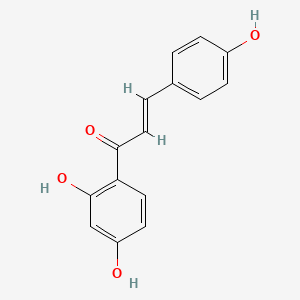| MeSH term | MeSH ID | Detail |
|---|---|---|
| Choroidal Neovascularization | D020256 | 5 associated lipids |
| Weight Loss | D015431 | 56 associated lipids |
| Uterine Neoplasms | D014594 | 18 associated lipids |
| Prostatic Neoplasms | D011471 | 126 associated lipids |
| Precancerous Conditions | D011230 | 48 associated lipids |
| Lung Neoplasms | D008175 | 171 associated lipids |
| Liver Neoplasms, Experimental | D008114 | 46 associated lipids |
| Leiomyoma | D007889 | 8 associated lipids |
| Glioma | D005910 | 112 associated lipids |
| Carcinoma, Adenoid Cystic | D003528 | 3 associated lipids |
isoliquiritigenin
Isoliquiritigenin is a lipid of Polyketides (PK) class. Isoliquiritigenin is associated with abnormalities such as abnormal fragmented structure, Gastric ulcer, Gastric mucosa lesion, Peptic Ulcer and Wiskott-Aldrich Syndrome. The involved functions are known as Mass-to-Charge Ratio, Anabolism, Oxidation, inhibitors and Energy Absorption. Isoliquiritigenin often locates in Microsomes, Liver, Hepatic, Microsomes, Immune system and Vacuole. The associated genes with Isoliquiritigenin are P4HTM gene, BCL2 gene, AP1AR gene, oxytocin, 1-desamino-(O-Et-Tyr)(2)- and ODAM gene. The related experimental models are Knock-out.
Cross Reference
Introduction
To understand associated biological information of isoliquiritigenin, we collected biological information of abnormalities, associated pathways, cellular/molecular locations, biological functions, related genes/proteins, lipids and common seen animal/experimental models with organized paragraphs from literatures.
What diseases are associated with isoliquiritigenin?
isoliquiritigenin is suspected in Gastric mucosa lesion, Gastric ulcer, Peptic Ulcer, Nodule, Infertility and other diseases in descending order of the highest number of associated sentences.
Related references are mostly published in these journals:
| Disease | Cross reference | Weighted score | Related literature |
|---|
Possible diseases from mapped MeSH terms on references
We collected disease MeSH terms mapped to the references associated with isoliquiritigenin
PubChem Associated disorders and diseases
What pathways are associated with isoliquiritigenin
There are no associated biomedical information in the current reference collection.
PubChem Biomolecular Interactions and Pathways
Link to PubChem Biomolecular Interactions and PathwaysWhat cellular locations are associated with isoliquiritigenin?
Visualization in cellular structure
Associated locations are in red color. Not associated locations are in black.
Related references are published most in these journals:
| Location | Cross reference | Weighted score | Related literatures |
|---|
What functions are associated with isoliquiritigenin?
Related references are published most in these journals:
| Function | Cross reference | Weighted score | Related literatures |
|---|
What lipids are associated with isoliquiritigenin?
Related references are published most in these journals:
| Lipid concept | Cross reference | Weighted score | Related literatures |
|---|
What genes are associated with isoliquiritigenin?
Related references are published most in these journals:
| Gene | Cross reference | Weighted score | Related literatures |
|---|
What common seen animal models are associated with isoliquiritigenin?
Knock-out
Knock-out are used in the study 'Two activators of in vitro fertilization in mice from licorice.' (Tung NH et al., 2015).
Related references are published most in these journals:
| Model | Cross reference | Weighted score | Related literatures |
|---|
NCBI Entrez Crosslinks
All references with isoliquiritigenin
Download all related citations| Authors | Title | Published | Journal | PubMed Link |
|---|---|---|---|---|
| Wu M et al. | Isoliquiritigenin decreases the incidence of colitis-associated colorectal cancer by modulating the intestinal microbiota. | 2016 | Oncotarget | pmid:27863401 |
| Wu CH et al. | Isoliquiritigenin induces apoptosis and autophagy and inhibits endometrial cancer growth in mice. | 2016 | Oncotarget | pmid:27708238 |
| Jin XY et al. | Isoliquiritigenin suppresses tumor necrosis factor-α-induced inflammation via peroxisome proliferator-activated receptor-γ in intestinal epithelial cells. | 2016 | Arch. Pharm. Res. | pmid:27539609 |
| Cao L- et al. | Isoliquiritigenin protects against triptolide-induced hepatotoxicity in mice through Nrf2 activation. | 2016 | Pharmazie | pmid:29441915 |
| Weis KE and Raetzman LT | Isoliquiritigenin exhibits anti-proliferative properties in the pituitary independent of estrogen receptor function. | 2016 | Toxicol. Appl. Pharmacol. | pmid:27702603 |
| Molitor C et al. | Aurone synthase is a catechol oxidase with hydroxylase activity and provides insights into the mechanism of plant polyphenol oxidases. | 2016 | Proc. Natl. Acad. Sci. U.S.A. | pmid:26976571 |
| Gaur R et al. | Drug Resistance Reversal Potential of Isoliquiritigenin and Liquiritigenin Isolated from Glycyrrhiza glabra Against Methicillin-Resistant Staphylococcus aureus (MRSA). | 2016 | Phytother Res | pmid:27388327 |
| Yang EJ et al. | The comparison of neuroprotective effects of isoliquiritigenin and its Phase I metabolites against glutamate-induced HT22 cell death. | 2016 | Bioorg. Med. Chem. Lett. | pmid:27815122 |
| Chen X et al. | Differentiation-inducing and anti-proliferative activities of isoliquiritigenin and all-trans-retinoic acid on B16F0 melanoma cells: Mechanisms profiling by RNA-seq. | 2016 | Gene | pmid:27461947 |
| Mahalingam S et al. | Effects of isoliquiritigenin on ovarian antral follicle growth and steroidogenesis. | 2016 | Reprod. Toxicol. | pmid:27773742 |
